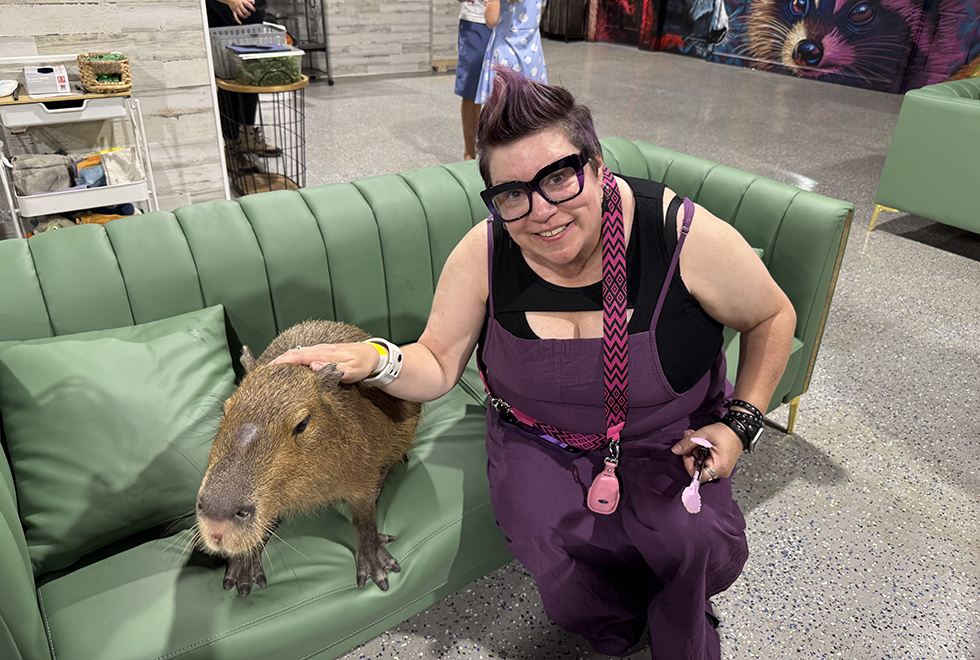If you had ever told me that I would enjoy feeding the world’s largest rodents, I would not have believed you. I am not generally a huge animal person, but I have to admit I was intrigued when I learned about the existence of the Capybara Café in St. Petersburg.
I decided to experience the Capybara Café while my son, Quinn, was home from college. Despite being allergic to both cats and dogs, he agreed to join me and we both hoped his allergies did not extend to rodents. (They didn’t!) When my best friend, Jamie, found out that we were going, she told me that her family also wanted to visit and we opted to go together.
We initially planned to book a Private Capybara Encounter Room for our group of seven, but that experience was fully booked. Instead, we purchased tickets for the Capybara Lounge, which accommodates up to 20 guests. It cost $49.74 per person.
Jamie purchased the tickets online and we were instructed to arrive 15 minutes before our 5 p.m. appointment. The café staff sent us liability waivers to fill out prior to our arrival. The café is located at 4703 Park Street North in an unassuming strip of shops about 10 minutes from downtown St. Petersburg and has its own parking lot.
When we entered the café, the lounge area was filled with people, animals and vinyl-covered furniture. We noticed that several guests were covered with fleece blankets and carrying what appeared to be kitchen tongs. We checked in and a staff member gave us yellow wrist bands, which identified us as being part of the group scheduled for 5 p.m. The visitors who were already in the lounge were all wearing red wristbands.
A few minutes before 5, one of the staff members gathered the yellow group together to share the rules. She told us that each of us would receive a large kale leaf (unless we had purchased more during the booking process) to feed the capybaras using the tongs we saw. She stressed the fact that the giant rodents are largely food-motivated and could mistake our fingers for dinner, which explained the use of the tongs. They also have sharp nails, so she recommended covering ourselves with the blankets provided to protect our clothing and exposed skin from accidental scratches.
Staff members asked us to clean our hands with the hand sanitizer provided, handed us our kale and tongs as we entered the lounge, and we were free to begin interacting with the animals. There were five capybaras, two large rabbits, a goat, a lamb and tortoises of varying sizes, all wandering freely. There were also a number of colorful birds perched near large red signs that said, “Warning: I Bite.” (We avoided those, for obvious reasons.)
I began tearing my kale leaf into smaller pieces and placing them onto my tongs. A capybara quickly approached and happily snatched the kale from my tongs. It allowed me to pet it while it munched on its snack, but quickly moved on when it realized my tongs were empty. I learned I had to keep the food coming consistently to keep the capybaras interested.
The capybaras are covered in wiry hair, and a staff member explained that they are semi-aquatic animals. They also have partially webbed feet. There were several staff members in the lounge with us, and when the capybaras seemed uninterested in interacting with us, the employees enticed them with chunks of apples and carrots.
My kale didn’t last long, but Jamie purchased more for our group. At one point I was feeding a capybara, and a goat butted its way in to get some kale. I fed the goat a few bites of kale, and when I stopped, it wouldn’t take no for an answer and proceeded to chew on my pants. Luckily, I quickly escaped with my clothing intact!
Even though there were about 20 guests, there was no shortage of interaction with the animals. Everyone took turns with the various creatures, and there were plenty of capybaras to go around. The staff members cleaned up immediately after the animals if there were any accidents, and at least some of the capybaras were trained to go in a tray in the corner of the room. There was plenty of furniture available to sit, but you could also wander throughout the lounge and approach animals that were hanging out in the open spaces.
When our experience was almost complete, we were given a five-minute warning. We returned our tongs, cleaned our hands with hand sanitizer, and viewed the decent selection of merchandise available for sale. My favorite was the shirt that read, “Don’t worry; Be Capy!,” as it was the perfect encapsulation of our experience at the Capybara Café.
KNOW BEFORE YOU GO:
- Visit capybaracafestpete.com to book your experience or for more information.
- In addition to the Capybara Lounge, you can visit the Lemur Lounge, experience a Mini Safari (wallaby, coatimundi and armadillo) or take advantage of the St. Pete – After Dark option (skunk, ringtail cat and fennec fox).
- All of the café’s profits go toward its parent organization, Noah’s Ark Sanctuary, a nonprofit dedicated to rescuing and rehabilitating animals in need.

